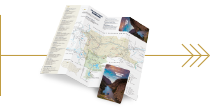Yellowstone: Off the Beaten Path
In summer, a swirl of cultures, accents and excitement accompanies Yellowstone’s most famous draws. It’s part of the experience, and it makes for top-notch people watching. But for introverts, unspoiled nature-lovers and seekers of quiet, here’s how to hog America’s most famous National Park all to yourself.Timing and Tactics
Freeze your adventure. Yellowstone National Park is more than open in winter—it’s a steamy, sparkly experience unto itself. But very few take advantage of the Park during this period and most winter months see less than 1% of the total annual visitors. No, you can’t drive yourself through the entire park in the winter, but there are other ways to get around. Drive the pretty Lamar Valley, ride a snowcoach to Old Faithful and other attractions, and ski and snowshoe blissfully tourist-free trails.
Hit the shoulder seasons. In the first week in October, the foliage peaks and visitor numbers plummet, but if you can’t hit the Park at that time, don’t worry. September until about mid-October is usually snow-free and less busy. If you don’t mind mixed hiking conditions, try May, when the trails are just starting to dry and the kids are still in school.
Step away from the vehicle. Have you heard the adage, just go a mile down the trail? It’s true—pick a hike and you’ll hoof it away from the hordes, even in the height of summer.
Get up early, or go out late. Dawn patrollers or dusk chasers can steal a few more quiet moments. As an added bonus, wildlife is usually on the move during these times, when tourists aren’t.
Make your day. In the summer, days of the week don’t matter—visitors tend to come weekend and weekdays alike. In the off-season, you’ll cut crowds a bit more by avoiding weekends. Midweek in the winter, the place is basically yours.
Lesser-Known Scenes
Drive the Old Gardiner Road Trail. Cruise the one-way, five-mile dirt trail, from behind the Mammoth Hotel up to Gardiner, to see bighorn and views over Mammoth Hot Springs—same view the stagecoaches saw in the 1880s. A sedan with higher clearance should be fine; just avoid low-riding vehicle rentals.
Hike to Monument Geyser Basin. A 1.25 uphill slog takes you to a lesser-traveled geyser basin—but it’s well worth the wind-sucking. Find the trailhead between Madison Junction and Norris Junction.
Skip Mt. Washburn and Hike Observation Peak instead. This 11-mile round-trip high-alpine trail clocks in nearly twice as long as uber-popular Mt. Washburn, but that just weeds out the wimps. Aim for late July and August to avoid snow and bring water or a water filter. Find the trailhead at Cascade Lake Picnic Area, in the Canyon region of the park.
Explore the Lamar Valley. The road from Tower-Roosevelt to Cooke City features more wildlife and fishing than geysers, so you’ll see a lot of binoculars, but comparatively fewer crowds.
Fish Cascade Lake. Finding a private place to cast can be tricky, but a 2.25-mile hike in takes you to a lesser-fished lake with hungry grayling and small cutthroat. Find the trailhead just north of Canyon Village.
Backpack the Bechler. Known as “Cascade Corner,” the Southwestern-most section of the Park sees few visitors, probably thanks to swarms of bugs and difficult river crossings. Hit it in the fall, though, when the bugs peter out, the rivers run slow and the blizzards haven’t struck yet, and a remote wonderland of tumbling waterfalls is all yours.
Backpackers must check in at the Bechler Ranger Station anyway, so head east 26 miles from Ashton, ID, to the ranger station, turning before the dead-end at Cave Falls. From there, you’re close to trailheads for Bechler Meadows, the Bechler Short Loop and Union Falls. Reserve a permit in advance, or plan to just do a day hike and camp out at Cave Falls.
Enjoy your trip—it sure won’t be like anyone else’s.


